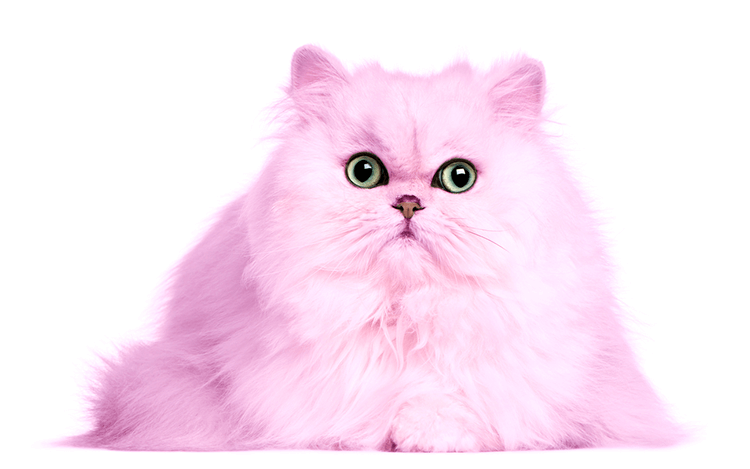When I was younger, I had a wall calendar featuring photographs of painted cats. Yes, painted cats. Most of them had multi-colored butterflies painted on their face. Some had been painted to look like upside-down koi fish and similar optical illusions. Others had stunning arabesque designs ebbing and flowing along the lengths of their bodies. The images were whimsical, otherworldly, and, as an artist and cat-lover, brought me a comforting kind of joy whenever I’d see them.
These images were from a book entitled “Why Paint Cats” by Burton Silver and Heather Busch. The book is intended to present “a new art movement that claims to promote a better understanding of the cats in our lives.” But don’t worry, these cats were not actually painted up as butterflies or koi fish. The artist used a clever and masterful method of painting over photos of cats in Photoshop. They were certainly entrancing images that inspired and fascinated me, however, as an adult, I am now faced with the question of whether or not it is safe to decorate our feline friends in such a way, in real life.
Rainbow Kitty
Let’s begin with one thing you should definitely not do, ever – use real hair dye on your cat (or dog!). Hair dye that is meant for humans has dangerous chemicals in it that can be incredibly toxic to your cat. In fact, some over-the-counter dyes aren’t even really that great for humans, either. Even the most gentle, vegan-approved hair dyes such as Manic Panic should not be used on your animal, simply because they were not designed for that purpose and may still contain chemicals that are not great for your baby bean, no matter how “natural” the box claims it to be.
Why? Simple. Not only could these chemicals potentially harm your kitty’s skin, but they would definitely not sit well in her stomach. Whatever you put on your pet, be it flea medicine, shampoo or what have you, there is a 99.9% chance that she is going to try to lick it off. Cats generally don’t like foreign substances on their fur or skin, hence why they are always licking themselves clean. Thusly, whatever product you use on your cat, it is always a good idea to make sure that it is a product that is specially designed for cats, or is so benign that it would pass through a cat’s digestive system with no issue.
Dye For Cats
So, is there anything you can safely use as a dye for your pet’s fur? Well, yes. Certain types of all-natural food coloring can be a safe choice for your pet. By no means should the food coloring contain harmful chemicals such as xylitol, however. Always consult with a vet before putting any product whatsoever on your pet’s skin or fur. Another alternative is making a dye out of certain cat-friendly fruits and veggies. Beets, for example, produce a beautiful purple-red color when used as a dye, and are not harmful to cats to consume (in moderation).
Lastly, there is a pet-safe color chalk on the market for cats and dogs. The chalk, called OPAWZ Pet Hair Chalk is non-toxic and temporary, and can easily be removed with one round of shampooing. But again, always consult with your vet who knows your cat’s health history before using any new products on them.
Is Dying My Cat Ethical?
So, to the question of can, you dye your cat’s fur safely? Yes, technically. Should you? That’s another matter. Cats deserve the same bodily autonomy as any other living creature. The question shouldn’t be whether or not it’s okay with you, but whether it’s okay with your cat. Some cats don’t bat an eye when you dress them up in babydoll clothes, and some go completely bonkers. Should you force a cat who clearly doesn’t want to wear the little sweater vest you bought him to wear it anyway? If you’ve incurred any flesh wounds in the process of trying to get it over his head, the answer is probably “no”. Similarly, if your cat is having a panic attack over the process of getting their fur dyed – then that’s your answer.
Additionally, you should never try to dye a cat’s fur who has any underlying health issues whatsoever, no matter what. Even if they’re super chill, a makeover such as this can be really stressful for your baby, even if she doesn’t show it. If she has a medical condition, the unnecessary tension of undergoing a beautification process might not be worth the novelty of having a blue cat. Gauge your cat’s reaction to the process and continue (or not) from there.
If you do choose to go forth and give Madame Whiskers a dip in some beet juice, make sure you are both doing so safely. Does the product you’re using have your vet’s approval? Is Madame Whiskers a healthy, happy, spry young lady? Has she consented to be purple? If the answer is a resounding “yes” down the list, then give it a shot and enjoy your indigo girl. (Ha!)







Hello, Diomira!
I loved the picture of the cat and would love to know if I could use it for my website.
Thanks a lot!